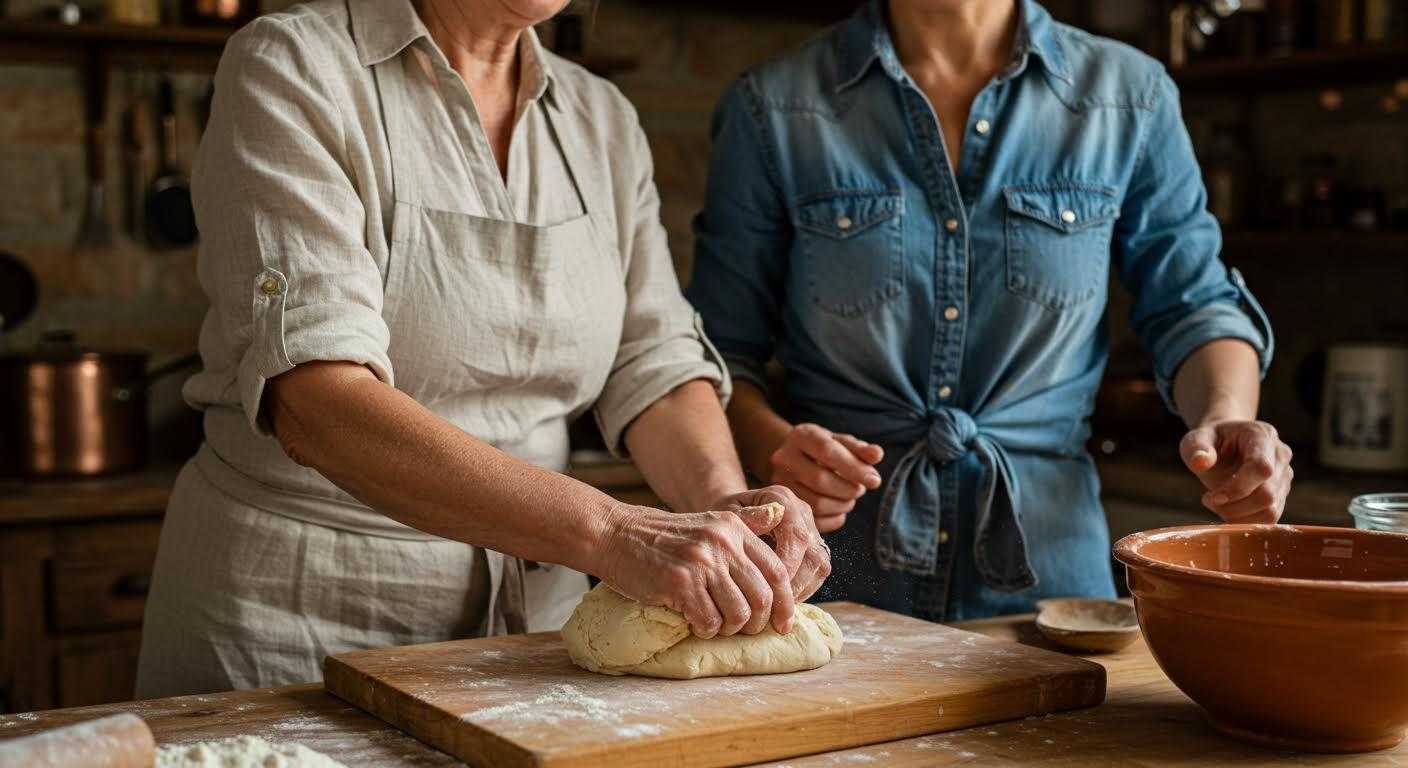Maria’s weathered hands moved through semolina flour like a conductor directing an invisible orchestra. Her kitchen hadn’t changed since 1953—terracotta tiles worn smooth, copper pans darkened by decades of use. This wasn’t Florence’s €225 cooking schools with their gleaming stainless steel. This was Chianti’s countryside, where three generations learned the same pici technique from the same wooden board.
I’d stumbled into her world through a friend’s whispered recommendation. No Eventbrite listing. No TripAdvisor reviews. Just Maria, 74 years old, teaching tourists to make pasta because her granddaughter moved to Milan and someone needed to carry forward eight centuries of tradition.
The Kitchen Where Tuscan Grandmothers Guard Pasta’s Soul
Maria’s stone farmhouse sits 12 kilometers from San Gimignano’s tourist crowds. Medieval towers fade into rolling hills dotted with olive groves that her family has tended since 1847. The kitchen breathes with history—exposed wooden beams from the 1600s, a stone fireplace that still heats the house.
No commercial pasta machines clutter the counters. No measuring cups or digital scales. Just the essentials: flour-dusted wooden boards, rolling pins carved by her grandfather, copper bowls that develop their patina through constant use. The absence of modern equipment isn’t rustic theater—it’s authenticity.
Morning light filters through windows unchanged since Renaissance times. This Mediterranean simplicity mirrors what I’d find in Tunisia’s coastal villages, where tradition survives through necessity rather than choice.
What Three Hours of Flour and Water Taught Me About Legacy
Maria’s hands tell stories her words cannot. Forty years of kneading have carved permanent flour lines into her palms. She guides my fingers through semolina, teaching texture through touch rather than measurement. “Senti,” she whispers. Feel.
The Rolling Pin Rhythm No Recipe Can Capture
Pici pasta requires a specific hand-rolling motion—part prayer, part meditation. Maria demonstrates the ancient technique: palms flat, fingers spread, rolling each strand to pencil thickness. The movement connects her to her grandmother, who learned from her grandmother.
Professional cooking schools teach efficiency. Maria teaches permanence. Each strand must be identical, not for aesthetic perfection, but because uniformity ensures even cooking. Her grandmother’s grandmother understood this before thermometers existed.
When Food Becomes Cultural Memory
No written recipes exist in Maria’s kitchen. Knowledge passes mother to daughter through demonstration, correction, repetition. She speaks of flour varieties her family has used for generations—tipo 00 from local mills, semolina ground fresh weekly.
This oral tradition predates Renaissance cookbooks. Medieval Tuscan families preserved recipes through muscle memory, seasonal rhythms, and intuitive understanding of ingredients. Similar protective practices guard Montreal’s culinary secrets from mass tourism.
From Tourist Observer to Kitchen Participant
My hands grow confident shaping ravioli parcels. Maria nods approval as I crimp edges with a fork—not the professional pleating technique taught in Florence, but her family’s method passed down through 6 generations. The pasta shapes stack on cotton towels like small prayers.
Shaping Pasta Like Tuscan Nonnas Have for Centuries
We prepare lunch using tomatoes from her garden, olive oil from trees planted in 1923. The pici cooks in salted water—no timer needed. Maria tests doneness by tasting, a skill requiring decades to master. Her movements flow with practiced efficiency born from feeding families, not entertaining tourists.
Fresh basil releases its perfume into the steam. Pecorino cheese grated moments before serving tastes nothing like supermarket versions. Each ingredient carries terroir—the specific taste of this place, this season, this moment.
The Lunch That Changed How I Taste Italy
We eat slowly, deliberately. Maria’s Chianti Classico costs €12 per bottle—a fraction of restaurant markup. Her ribollita soup, thick with day-old bread and garden vegetables, embodies Tuscan frugality transformed into luxury through time and technique.
Conversation flows between Italian and broken English. Maria shares stories of harvest seasons, winter preserving, the gradual disappearance of neighborhood pasta-makers. Rural traditions everywhere face similar pressures from modernization and tourism.
Why Michelin Stars Can’t Teach What Maria’s Kitchen Does
Florence’s cooking schools offer technical precision for €200-300 per person. Maria charges €120 including lunch, wine, and something invaluable—connection to living tradition. Professional chefs teach methods. Nonnas teach meaning.
The difference reveals itself in details. Commercial classes emphasize presentation and Instagram moments. Maria focuses on taste, texture, family memories embedded in each technique. Her pasta isn’t photogenic—it’s genuine.
This kitchen transforms tourists into temporary family members. Cultural preservation happens through participation, not observation. Maria’s gift isn’t just pasta—it’s belonging.
Your Questions About Learning Pasta from a Tuscan Nonna Answered
How Much Does an Authentic Nonna Pasta Class Cost in Tuscany?
Genuine countryside experiences with local grandmothers range €80-160 per person including lunch and wine. Florence’s commercial cooking schools charge €200-300. Authentic agriturismo classes offer better value and deeper cultural connection than city-based tourist operations.
What Makes Nonna’s Pasta Technique Different from Chef Classes?
Nonnas teach through generational demonstration emphasizing feel over measurements. They share family recipes preserved through oral tradition rather than culinary school standardization. The experience includes family meal-sharing and cultural context missing from professional instruction.
Is Learning in Tuscany More Authentic Than Amalfi Coast Cooking Classes?
Tuscan countryside offers more intimate family experiences compared to Amalfi’s commercial tourism focus. Tuscany’s agriturismo tradition provides genuine home kitchens versus coastal demonstration spaces. Prices remain 15-20% lower than seaside alternatives while offering deeper cultural immersion.
Afternoon shadows lengthened across Maria’s olive groves as flour dust settled on weathered windowsills. My imperfect pici dried on cotton towels—crooked, authentic, mine. Some knowledge transfers through hands, not books. In Maria’s kitchen, I touched eight centuries of tradition, one pasta strand at a time.
